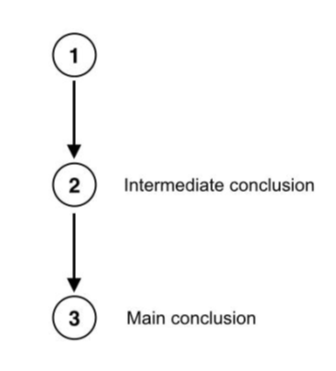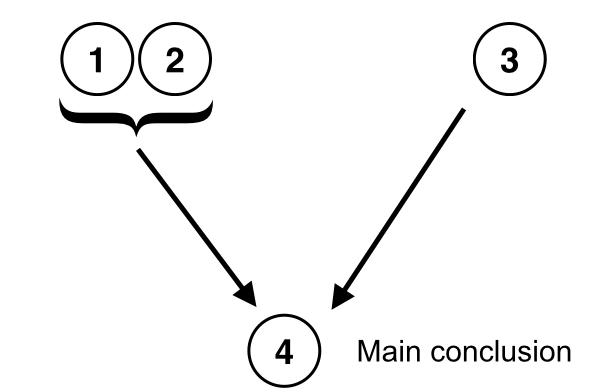2.4 More complex argument structures
LEARNING OBJECTIVES
By the end of this section you will discover:
- How to recognize and chart more complicated arguments.
So far, we have seen that an argument consists of a premise (typically more than one) and a conclusion. However, very often arguments and explanations have a more complex structure than just a few premises that directly support the conclusion. For example, consider the following argument:
The main conclusion of this argument—the statement that depends on other statements as evidence but doesn’t itself provide any evidence for any other statement—is:
This account of the eruption of Mt. Vesuvius was not actually written by an eyewitness.
However, the argument’s structure is more complex than simply having a couple of premises that provide evidence directly for the conclusion. Rather, some statement provides evidence directly for the main conclusion, but that statement itself is supported by another statement. To determine the structure of an argument, we must determine which statements support which. We can use our premise and conclusion indicators to help with this. For example, the passage contains the phrase, “the reason is…” which is a premise indicator, and it also contains the conclusion indicator, “therefore.” That conclusion indicator helps us to identify the main conclusion, but the more important thing to see is that statement A does not itself provide evidence or support for any of the other statements in the argument, which is the clearest reason why statement A is the main conclusion of the argument. The next question we must answer is: which statement most directly supports A? What most directly supports A is:
However, there is also a reason offered in support of B. That reason is that:
So, the main conclusion (A) is directly supported by B, and B is supported by C. Since B acts as a premise for the main conclusion but is also itself the conclusion of further premises, we refer to B as an intermediate conclusion. The important thing to recognize here is that one and the same statement can act as both a premise and a conclusion. Statement B is a premise that supports the main conclusion (A), but it is also itself a conclusion that follows from C. Here is how we would put this complex argument into standard form (using numbers this time, as we always do when putting an argument into standard form):
- The lava from Mt. Vesuvius was flowing too fast and there was nowhere for someone living in Pompeii to go in order to escape it in time.
- Therefore, no one living in Pompeii could have survived the eruption of Mt. Vesuvius. (from 1)
- Therefore, this account of the eruption of Mt. Vesuvius was not actually written by an eyewitness. (from 2)
Notice that at the end of statement 2 I have written in parentheses “from 1” (and likewise at the end of statement 3 I have written “from 2”). This is a shorthand way of saying: “this statement follows from statement 1.” We will use this convention as a way of keeping track of the structure of the argument. It may also help to think about the structure of an argument spatially, as figure 1 shows:

The main argument here (from 2 to 3) contains a subargument, in this case the argument from 1 to 2. A subargument, as the term suggests, is a part of an argument that provides indirect support for the main argument. The main argument is simply the argument whose conclusion is the main conclusion.
Another type of structure that arguments can have is when two or more premises provide direct but independent support for the conclusion. Here is an example of an argument with that structure:
The conclusion of this argument is “Wanda rode her bike to work today” and there are two premises that provide independent support for it: the fact that Wanda had her pant leg cuffed and the fact that Bob saw her riding her bike. Here is the argument in standard form:
- Wanda arrived at work with her right pant leg rolled up.
- Cyclists often roll up their right pant leg.
- Bob saw Wanda riding her bike towards work at 7:45.
- Therefore, Wanda rode her bike to work today. (from 1-2, 3 independently)
Again, notice that next to statement 4 of the argument I have written the premises from which that conclusion follows. In this case, in order to avoid any ambiguity, I have noted that the support for the conclusion comes independently from statements 1 and 2, on the one hand, and from statement 3, on the other hand. It is important to point out that an argument or subargument can be supported by one or more premises. We see this in the present argument since the conclusion (4) is supported jointly by 1 and 2, and singly by 3.
As before, we can represent the structure of this argument spatially, as figure 2 shows:
Figure 2

There are endless different argument structures that can be generated from these few simple patterns. At this point, it is important to understand that arguments can have these different structures and that some arguments will be longer and more complex than others. Determining the structure of very complex arguments is a skill that takes some time to master. Even so, it may help to remember that any argument structure ultimately traces back to some combination of these.
Exercise 4: Write the following arguments in standard form and show how the argument is structured using a diagram like the ones I have used in this section.
There is nothing wrong with prostitution because there is nothing wrong with consensual sexual and economic interactions between adults. Moreover, since there’s no difference between a man who goes on a blind date with a woman, buys her dinner and then has sex with her and a man who simply pays a woman for sex, that is another reason for why there is nothing wrong with prostitution.
Prostitution is wrong because it involves women who have typically been sexually abused as children. We know that most of these women have been abused from multiple surveys done with women who have worked in prostitution and that show a high percentage of self-reported sexual abuse as children.
There was someone in this cabin recently because there was warm water in the tea kettle and because there was wood still smoldering in the fireplace. But the person couldn’t have been Tim because Tim has been with me the whole time. Therefore, there must be someone else in these woods.
It is possible to be blind and yet run in the Olympic Games since Marla Runyan did it at the 2000 Sydney Olympics.
The train was late because it had to take a longer, alternate route since the bridge was out.
Israel is not safe if Iran gets nuclear missiles since Iran has threatened multiple times to destroy Israel and if Iran had nuclear missiles, it would be able to carry out this threat. Moreover, since Iran has been developing enriched uranium, they have the key component needed for nuclear weapons—every other part of the process of building a nuclear weapon is simple compared to that. Therefore, Israel is not safe.
Since all professional hockey players are missing front teeth and Martin is a professional hockey player; it follows that Martin is missing front teeth. And since almost all professional athletes who are missing their front teeth have false teeth, it follows that Martin probably has false teeth.
Anyone who eats the crab rangoon at China Food restaurant will probably have stomach troubles afterward. It has happened to me every time, which is why it will probably happen to other people as well. Since Bob ate the crab rangoon at China Food restaurant, he will probably have stomach troubles afterward.
Albert and Caroline like to go for runs in the afternoon in Hyde Park. Since Albert never runs alone, we know that any time Albert is running, Caroline is running too. But since Albert looks like he has just run (since he is panting hard), it follows that Caroline must have run too.
Just because Jeremy’s prints were on the gun that killed Tim and the gun was registered to Jeremy; it doesn’t follow that Jeremy killed Tim since Jeremy’s prints would certainly be on his own gun and someone else could have stolen Jeremy’s gun and used it to kill Tim.

